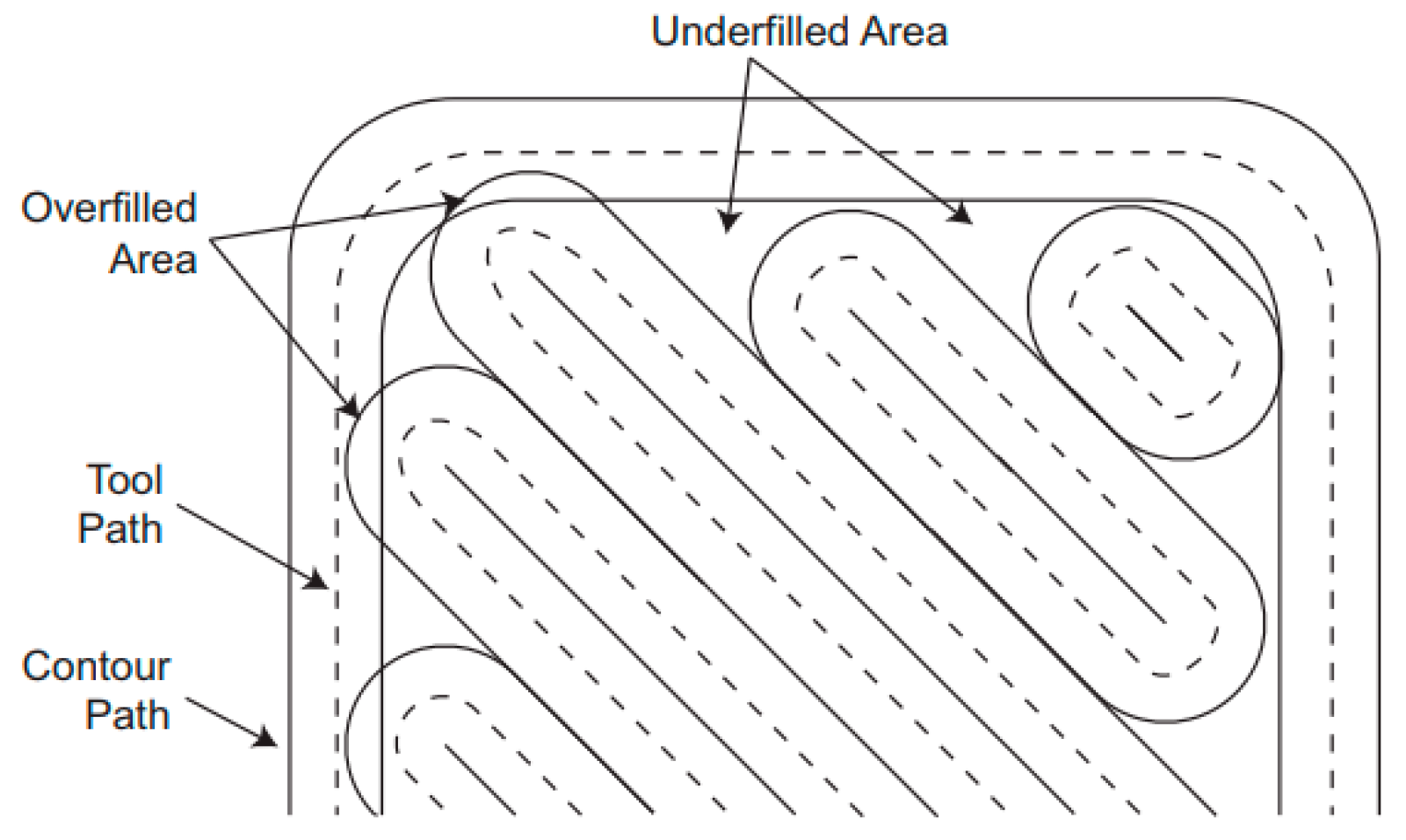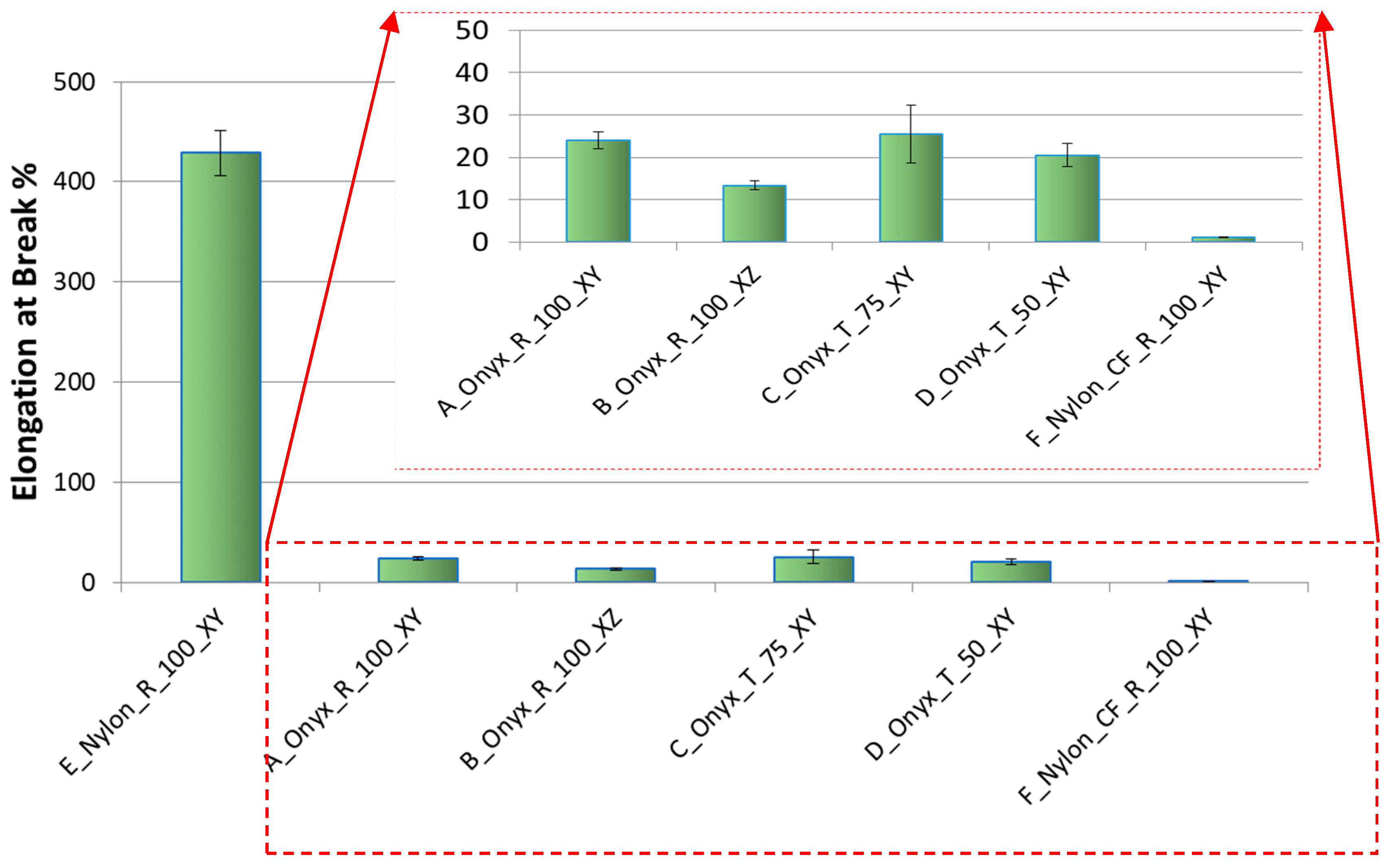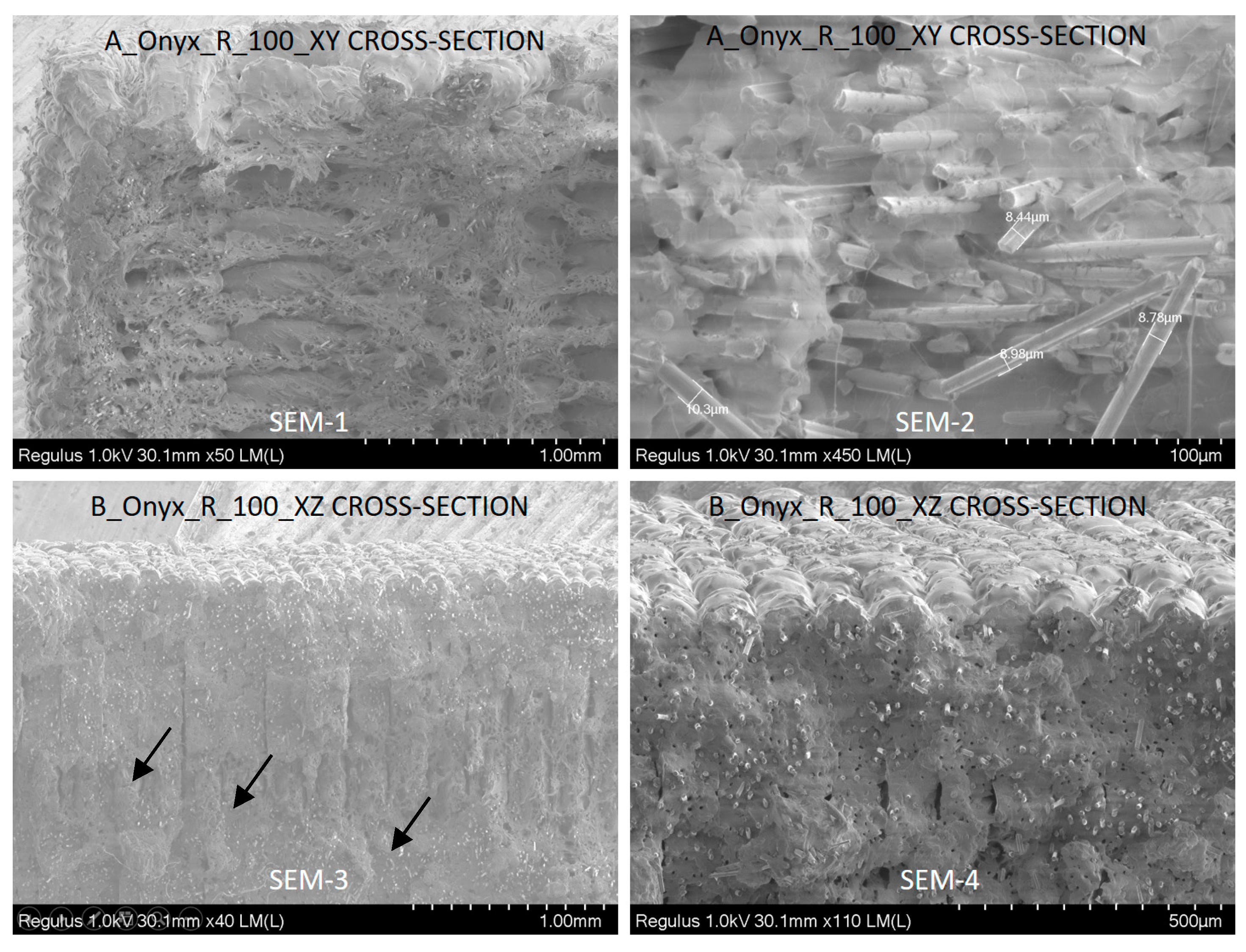Dimensional Accuracy and Mechanical Properties of Chopped Carbon Reinforced Polymers Produced by Material Extrusion Additive Manufacturing
Abstract
:1. Introduction
2. Materials and Methods
3. Results
3.1. Dimensional Accuracy and Geometrical Features
3.2. Tensile and Hardness Testing
3.3. Microscopy
4. Conclusions
Author Contributions
Funding
Acknowledgments
Conflicts of Interest
References
- Yakout, M.; Elbestawi, M.A. Additive Manufacturing of Composite Materials: An Overview. In Proceedings of the 6th International Conference on Virtual Machining Process Technology (VMPT), Montréal, QC, Canada, 29 May–2 June 2017. [Google Scholar]
- ISO/ASTM52900. Standard Terminology for Additive Manufacturing—General Principles—Terminology. ISO/ASTM International. 2015. Available online: https://infostore.saiglobal.com/preview/258188796473.pdf?sku=880295_SAIG_NSAI_NSAI_2091401 (accessed on 1 September 2019).
- Mehrpouya, M.; Dehghanghadikolaei, A.; Fotovvati, B.; Vosooghnia, A.; Emamian, S.S.; Gisario, A. The Potential of Additive Manufacturing in the Smart Factory Industrial 4.0: A Review. Appl. Sci. 2019, 9, 3865. [Google Scholar] [CrossRef]
- Tekinalp, H.L.; Kunc, V.; Velez-Garcia, G.M.; Duty, C.E.; Love, L.J.; Naskar, A.K.; Blue, C.A.; Ozcan, S. Highly oriented carbon fiber-polymer composites via additive manufacturing. Compos. Sci. Technol. 2014, 105, 144–150. [Google Scholar] [CrossRef]
- Zhong, W.; Li, F.; Zhang, Z.; Song, L.; Li, Z. Short fiber reinforced composites for fused deposition modeling. Mater. Sci. Eng. A 2001, 301, 125–130. [Google Scholar] [CrossRef]
- Ning, F.; Cong, W.; Qui, J.; Wei, J.; Wang, S. Additive Manufacturing of carbon fiber reinforced thermoplastic composites using fused deposition modeling. Compos. Part B 2015, 80, 369–378. [Google Scholar] [CrossRef]
- Duty, C.; Ajinjeru, C.; Kishore, V.; Compton, B.; Hmeidat, N.; Chen, X.; Liu, P.; Hassen, A.A.; Lindahl, J.; Kunc, V. What makes a material printable? A viscoelastic model for extrusion-based 3D printing of polymers. J. Manuf. Process. 2018, 35, 526–537. [Google Scholar] [CrossRef]
- Ferreira, R.T.L.; Amatte, I.C.; Dutra, T.A.; Bürger, D. Experimental characterization and micrography of 3D printed PLA and PLA reinforced with short carbon fibers. Compos. Part B Eng. 2017, 124, 88–100. [Google Scholar] [CrossRef]
- Liu, Z.; Lei, Q.; Xing, S. Mechanical characteristics of wood, ceramic, metal and carbon fiber-based PLA composites fabricated by FDM. J. Mater. Res. Technol. 2019, 8, 3741–3751. [Google Scholar] [CrossRef]
- Papon, E.A.; Haque, A. Fracture toughness of additively manufactured carbon fiber reinforced composites. Addit. Manuf. 2019, 26, 41–52. [Google Scholar] [CrossRef]
- Rao, V.D.P.R.; Rajiv, P.; Geethika, V.N. Effect of fused deposition modelling (FDM) process parameters on tensile strength of carbon fibre PLA. Mater. Today Proc. 2019. [Google Scholar] [CrossRef]
- Yasa, E. Anisotropic impact toughness of chopped carbon fiber reinforced nylon fabricated by material extrusion based additive manufacturing. Eskiseh. Tech. Univ. J. Sci. Technol. A Appl. Sci. Eng. 2019, 20, 195–203. [Google Scholar]
- Yao, X.; Luan, C.; Zhang, D.; Lan, L.; Fu, J. Evaluation of carbon fiber-embedded 3D printed structures for strengthening and structural-health monitoring. Mater. Design 2017, 114, 424–432. [Google Scholar] [CrossRef]
- Gardner, J.M.; Sauti, G.; Kim, J.W.; Cano, R.J.; Wincheski, R.A.; Stelter, C.J.; Grimsley, B.W.; Working, D.C.; Siochi, E.J. 3-D Printing of multifunctional carbon nanotube yarn reinforced components. Addit. Manuf. 2016, 12, 38–44. [Google Scholar] [CrossRef]
- Parandoush, P.; Tucker, L.; Zhou, C.; Lin, D. Laser Assisted Additive Manufacturing of Continuous Fiber Reinforced Thermoplastic Composites. Mater. Design 2017, 131, 186–195. [Google Scholar] [CrossRef]
- Tian, X.; Liu, T.; Yang, C.; Wang, Q.; Li, D. Interface and performance of 3D printed continuous carbon fiber reinforced PLA composites. Compos. Part A 2016, 88, 198–205. [Google Scholar] [CrossRef]
- Matsuzaki, R. 3D Printer Using Continuous Carbon Fiber Composite Materials. Available online: http://www.jscm.gr.jp/3Dprinting/images/introduction_CFRP3Dprinter.pdf (accessed on 24 July 2018).
- Matsuzaki, R.; Ueda, M.; Namiki, M.; Jeong, T.K.; Asahara, H.; Horiguchi, K.; Nakamura, T.; Todoroki, A.; Hirano, Y. Three-dimensional printing of continuous-fiber composites by in-nozzle impregnation. Sci. Rep. 2016, 6, 23058. [Google Scholar] [CrossRef]
- Dickson, A.N.; Barry, J.N.; McDonnel, K.A.; Dowling, D.P. Fabrication of continuous carbon, glass and Kevlar fibre reinforced polymer composites using additive manufacturing. Addit. Manuf. 2017, 16, 146–152. [Google Scholar] [CrossRef]
- Scrocco, M.; Chamberlain, T.; Chow, C.; Weinreber, L.; Ellks, E.; Halford, C.; Cortes, P.; Conner, B.P. 2018, Impact Testing of 3D Printed Kevlar-Reinforced Onyx Material. In Proceedings of the 29th Annual International Solid Freeform Fabrication 2018, Austin, TX, USA, 13–15 August 2018. [Google Scholar]
- Van der Klift, F. 3D Printed Unidirectional Carbon Fibre Reinforced Polymers for Aerospace Applications. Master’s Thesis, The Delft University of Technology, Delft, The Netherlands, 2017. [Google Scholar]
- Heidari-Rarani, M.; Rafiee-Afarani, M.; Zahedi, A.M. Mechanical characterization of FDM 3D printing of continuous carbon fiber reinforced PLA composites. Compos. Part B Eng. 2019, 175, 107–147. [Google Scholar] [CrossRef]
- Tian, X.; Liu, T.; Wang, Q.; Dilmurat, A.; Li, D.; Ziegmann, G. Recycling and remanufacturing of 3D printed continuous carbon fiber reinforced PLA composites. J. Cleaner Prod. 2017, 142, 1609–1618. [Google Scholar] [CrossRef]
- Mori, K.; Maeno, T.; Nakagawa, Y. Dieless forming of carbon fibre reinforced plastic parts using 3D printer. Procedia Eng. 2014, 81, 1595–1600. [Google Scholar] [CrossRef]
- Bourell, D.; Kruth, J.-P.; Leu, M.; Levy, G.; Rosen, D.; Beese, A.M.; Clare, A. Materials for additive manufacturing. CIRP Ann. Manuf. Technol. 2017, 66, 659–681. [Google Scholar] [CrossRef]
- 3D Printing Settings Impacting Part Strength from. Available online: https://markforged.com/learn/3d-printing-settings-impacting-part-strength/; last visited on 09/10/2019 (accessed on 23 July 2018).
- How to Choose an Infill for Your 3D Prints from. Available online: https://3dprinting.com/tips-tricks/how-to-choose-an-infill-for-your-3d-prints/; last visited on 09/10/2019 (accessed on 23 July 2018).
- Engkvist, G. Investigation of Microstructure and Mechanical Properties of 3D Printed Nylon, Materials Engineering. Master’s Thesis, Luleå University of Technology, Luleå, Sweden, 2017. [Google Scholar]
- Markforged 3D Printers from. Available online: https://mlc-cad.com/markforged/; last visited on 10/10/2019 (accessed on 23 July 2018).
- Kruth, J.P.; Vandenbroucke, B.; Van Vaerenbergh, J.; Mercelis, P. 2005, Benchmarking of different SLS/SLM processes as rapid manufacturing techniques. In Proceedings of the International Conference Polymers & Moulds Innovations (PMI), Gent, Belgium, 20–23 April 2005; Available online: https://ris.utwente.nl/ws/portalfiles/portal/5676701 (accessed on 1 September 2019).
- Unkovskiy, A.; Spintzyk, S.; Axmann, D.; Engel, E.-M.; Weber, H.; Huettig, F. Additive Manufacturing: A Comparative Analysisof Dimensional Accuracy and Skin Texture Reproductionof Auricular Prostheses Replicas. J. Prosthodont. 2019, 28, e460–e468. [Google Scholar] [CrossRef] [PubMed]
- Carneiro, O.S.; Silva, A.F.; Gomes, R. Fused deposition modeling with polypropylene. Mater. Design 2015, 83, 768–776. [Google Scholar] [CrossRef]
- Blok, L.G.; Longana, M.L.; Yu, H.; Woods, B.K.S. An investigation into 3D printing of fibre reinforced thermoplastic composites. Addit. Manuf. 2018, 22, 176–186. [Google Scholar] [CrossRef]
- Yasa, E.; Poyraz, O.; Solakoglu, E.U.; Akbulut, G.; Oren, S. A Study on the Stair Stepping Effect in Direct Metal Laser Sintering of a Nickel-based Superalloy. Procedia CIRP 2016, 45, 175–178. [Google Scholar] [CrossRef]
- Magdeski, J.S. The porosity dependence of mechanical properties of sintered alumina. J. Univ. Chem. Technol. Metall. 2010, 45, 143–148. [Google Scholar]
- Weber, M.; Baumeister, J.; Banhart, J.; Kunze, H.D. 1994, Selected mechanical and physical properties of metal foams. In Proceedings of the Powder Metallurgy World Congress PM94, Paris, France, 6–9 June 1994; pp. 585–588. [Google Scholar]
- Ziminska, M.; Dunne, N.; Hamilton, A.R. Porous Materials with Tunable Structure and Mechanical Properties via Templated Layer-by-Layer Assembly. ACS Appl. Mater. Interfaces 2016, 8, 21968–21973. [Google Scholar] [CrossRef]
- Naranjo-Lozada, J.; Ahuett-Garza, H.; Orta-Castañón, P.; Verbeeten, M.H.; Sáiz-González, D. Tensile properties and failure behavior of chopped and continuous carbon fiber composites produced by additive manufacturing. Addit. Manuf. 2019, 26, 227–241. [Google Scholar] [CrossRef]




















| No. | Part Name | Material | Infill | % Density | Fiber | Layer Thickness | Build Direction |
|---|---|---|---|---|---|---|---|
| 1 | E_Nylon_R_100_XY | NYLON | Rectangular | 100% | None | 0.1 mm | XY plane |
| 2 | A_Onyx_R_100_XY | ONYX | Rectangular | 100% | None | 0.1 mm | XY plane |
| 3 | B_Onyx_R_100_XZ | ONYX | Rectangular | 100% | None | 0.1 mm | XZ plane |
| 4 | C_Onyx_T_75_XY | ONYX | Triangular | 75% | None | 0.1 mm | XY plane |
| 5 | D_Onyx_T_50_XY | ONYX | Triangular | 50% | None | 0.1 mm | XY plane |
| 6 | F_Nylon_CF_R_100_XY | NYLON | Rectangular | 100% | Carbon | 0.125 mm | XY plane |
© 2019 by the authors. Licensee MDPI, Basel, Switzerland. This article is an open access article distributed under the terms and conditions of the Creative Commons Attribution (CC BY) license (http://creativecommons.org/licenses/by/4.0/).
Share and Cite
Yasa, E.; Ersoy, K. Dimensional Accuracy and Mechanical Properties of Chopped Carbon Reinforced Polymers Produced by Material Extrusion Additive Manufacturing. Materials 2019, 12, 3885. https://doi.org/10.3390/ma12233885
Yasa E, Ersoy K. Dimensional Accuracy and Mechanical Properties of Chopped Carbon Reinforced Polymers Produced by Material Extrusion Additive Manufacturing. Materials. 2019; 12(23):3885. https://doi.org/10.3390/ma12233885
Chicago/Turabian StyleYasa, Evren, and Kıvılcım Ersoy. 2019. "Dimensional Accuracy and Mechanical Properties of Chopped Carbon Reinforced Polymers Produced by Material Extrusion Additive Manufacturing" Materials 12, no. 23: 3885. https://doi.org/10.3390/ma12233885





